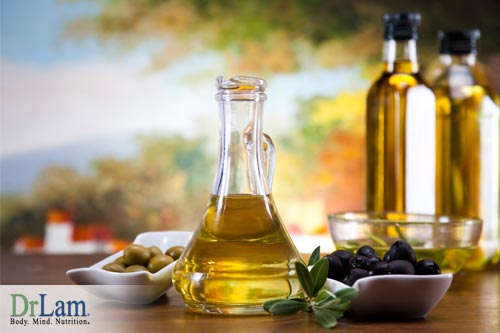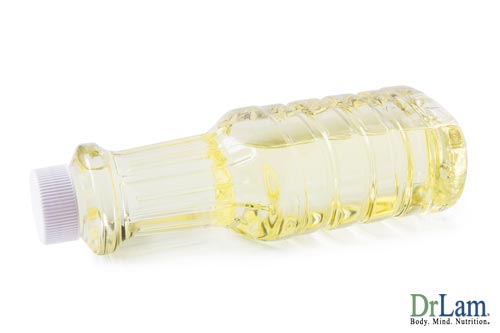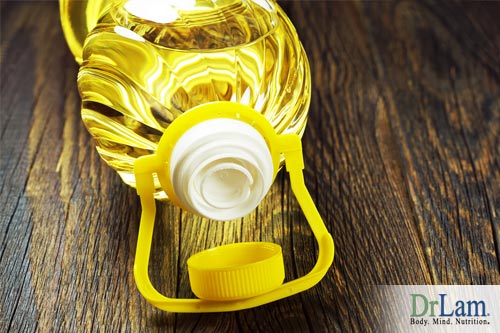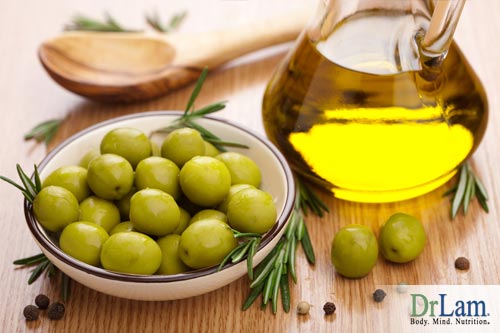 With more and more health-conscious people switching to healthier oils these days, one of the primary concerns becomes, what happens to olive oil when it's heated and/or used for frying? And while there are a number of health-related issues to consider when choosing an oil, health experts say that the most important thing to remember when cooking with oil (olive or any other) is not to heat it beyond its "smoking point" or the smoke point of cooking oils. The smoke point of cooking oils is the temperature at which it begins to smoke or burn and give food an unpleasant taste.
With more and more health-conscious people switching to healthier oils these days, one of the primary concerns becomes, what happens to olive oil when it's heated and/or used for frying? And while there are a number of health-related issues to consider when choosing an oil, health experts say that the most important thing to remember when cooking with oil (olive or any other) is not to heat it beyond its "smoking point" or the smoke point of cooking oils. The smoke point of cooking oils is the temperature at which it begins to smoke or burn and give food an unpleasant taste.
So, what is the “smoke point” of olive oil? Well, that depends on where you look and who you ask.
As any chef can tell you, the smoke point of cooking oils depends on its type and quality. High quality extra virgin olive oils, for example (with low, free fatty acids) have a high smoke point. These oils are, of course, an excellent choice for cooking, but due to the meticulous processing method are an expensive one. Low quality olive oils, on the other hand--which have a much lower smoke point--are mass produced and comparatively less expensive to use. Thus, the initial issue is cost vs quality.
According to one web source, the Olive Oil Source, extra virgin olive oil smokes at temperatures between 400ºF and 365ºF (204ºC and 185ºC) depending on its “free fatty acid content.” The International Olive Oil Council (IOOC) website goes into greater detail, stating: “When heated, olive oil is the most stable fat, which means it stands up well to high frying temperatures. Its high smoke point (410ºF or 210ºC) is well above the ideal temperature for frying food (356ºF or 180ºC). The smoke point of cooking oils like olive oil does not affect the digestibility when it is heated , even when it is re-used several times for frying.” The IOOC also provides this reference table comparing standard cooking temperatures for various foods:
| Type of Food | Cooking Temperature |
|---|---|
| High water content: vegetables, potatoes, fruit | Medium (266-293ºF or 130-145ºC) |
| Coated in batter, flour or breadcrumbs, forming a crust | Hot (311-338ºF or 155-170ºC) |
| Small, quickly fried: small fish, croquettes | Very Hot (347-374ºF or 175–190ºC) |
But, how does olive oil stack up to the smoke point of cooking oils like grapeseed, avocado, sesame, canola or macadamia? The table below shows the smoke point for a few other commonly-used cooking oils. (Bear in mind that the smoke point for a vegetable oil will vary considerably according to the type, growing conditions of the “vegetable” used, and how the oil is processed. Also note that various manufacturers cite different statistics for their products—as well as their competitors.
| Type of Oil | Smoke Point of Cooking Oils |
|---|---|
| Grape Seed | 485ºF or 252ºC |
| Avocado | 480ºF or 249ºC |
| Sesame | 410ºF or 210ºC |
| Canola | 400ºF or 204ºC |
| Macademia | 385ºF or 196ºC |
But, if you're like most consumers, statistics— particularly when they can greatly vary--only add to the confusion. So, here are some other points to consider when making your “oil” decision.
 As older consumers know well, a few decades ago the choices were pretty cut-and-dry: Tradition dictated that you used a liquid canola or corn oil for frying or sauteing -a solid vegetable shortening like Crisco for baking. Today, however, there is a virtual arsenal of so-called “boutique oils” with pumpkin seed, soy, peanut, sunflower seed, avocado, borage, and camellia just the tip of the proverbial oil iceberg. And in that all seeds naturally contain oil, business savvy and desire to create a “niche” market for a new oil has led to the extraction of many unusual, exotic oils never previously considered for consumption or cooking. This has resulted in a number of marketing strategies that have asked consumers to think well outside the traditional box.
As older consumers know well, a few decades ago the choices were pretty cut-and-dry: Tradition dictated that you used a liquid canola or corn oil for frying or sauteing -a solid vegetable shortening like Crisco for baking. Today, however, there is a virtual arsenal of so-called “boutique oils” with pumpkin seed, soy, peanut, sunflower seed, avocado, borage, and camellia just the tip of the proverbial oil iceberg. And in that all seeds naturally contain oil, business savvy and desire to create a “niche” market for a new oil has led to the extraction of many unusual, exotic oils never previously considered for consumption or cooking. This has resulted in a number of marketing strategies that have asked consumers to think well outside the traditional box.
For example, some oils are touted for their exceptional health benefits; others for their unique flavor. Consumers of Argan oil (a tree native to Morocco) and Shea butter oil (of the African Shea tree) have become associated with supporting women's cooperatives in developing nations, while hemp seed oil advocates taunt societal convention while promoting it for everything from heart-health to acne, cancer to premenstrual stress relief. Similarly, Jojoba is deemed “earth-friendly,” and grapeseed oil is said to have the power to restore one's natural beauty. And while it's difficult to dispute some of these promotional claims, in terms of cooking, there is one point that should be easy to compare: the smoke point. But is it?
As we know, a high smoke point is desirable for cooking. This is primarily due to the fact that when frying, the best results come from oil that is quite hot—producing food that is crispy on the outside, tender on the inside. (In her popular book The Joy of Cooking, Irma Rombauer--considered by many one of the premier authorities on cooking--recommends frying at 365ºF for best results.) Foods cooked at just the right temperature undergo a process by which the natural sugars caramelize, allowing a thin, protective shell to form on the outside that keeps food from absorbing too much oil--and becoming oil-soaked. But what is the right temperature for olive oil?
Even a cursory web-search of the smoke points of various oils (by various manufacturers) will likely uncover several interesting facts about this issue. For one, you will likely discover that most every oil distributor claims their oil has the highest smoke point. (One site for Macadamia nut oil puts their oil at the top of the list with a smoke point of 410ºF—rating olive oil at 190ºF. One avocado oil site states that their oil has the highest smoke point—claiming that all “nut oils” are terrible for frying.)
 Secondly, if you visit any of the dozens of vegetable oil sites, you'll discover that vegetable oil smoke point ratings will vary not just according to the type of vegetable product used, conditions under which that product is grown, and how the oil is processed—but by brand. (One promotes their oil by warning against unfiltered olive oil because it contains small bits of olive in it—which when heated will burn and smoke before the oil itself—thus disqualifying unfiltered olive oil as suitable for cooking.)
Secondly, if you visit any of the dozens of vegetable oil sites, you'll discover that vegetable oil smoke point ratings will vary not just according to the type of vegetable product used, conditions under which that product is grown, and how the oil is processed—but by brand. (One promotes their oil by warning against unfiltered olive oil because it contains small bits of olive in it—which when heated will burn and smoke before the oil itself—thus disqualifying unfiltered olive oil as suitable for cooking.)
So, who do you trust for the actual smoke point of olive oil? Perhaps it's best to just purchase a few varieties and a frying thermometer, and conduct your own tests! This is particularly sage advice considering that environmental conditions (such as altitude) have been proven to change boiling points. Why take chances—just conduct your own experiments!
With the increasing popularity of cooking with olive oil, a number of myths have begun to circulate regarding oil saturation and nutritional concerns. Here are two of the most common:
One common myth concerning the use of olive oil for cooking is that heating olive oil will make it saturated or “trans-fatty.” Untrue. According to world-renowned oil chemist Dr. A. Kiritsakis in his book Olive Oil From the Tree to the Table, “As far as making a saturated fat, all oils will oxidize and hydrogenate to a tiny degree if repeatedly heated to very high temperatures such as is done in commercial frying operations. Olive-Pomace oils and virgin olive oils are both highly monounsaturated oils and therefore resistant to oxidation and hydrogenation. Studies have shown oxidation and hydrogenation occurs to a lesser degree in olive oil than in other oils. But in any case, the amount of hydrogenation is minuscule and no home cook would ever experience this problem.”
To better understand the saturated or trans-fatty issue, it's important to understand that in the factory setting where unsaturated vegetable oils are processed into margarine or a solid vegetable product, they do so by bubbling hydrogen gas through hot vegetable oil, or the smoke point of cooking oils (250ºF to 400ºF/121ºC to 204ºC), in the presence of a metal catalyst--usually nickel or platinum; a process that can take several hours. In the home setting, however, these conditions are nearly impossible to replicate—making the production (even accidentally) of a saturated or trans-fatty product (like margarine) virtually impossible. Thus, the “saturated/trans-fatty issue” is actually a non-issue.
 Another common myth regarding the use of olive oil in cooking is that it reduces the nutritional value of food. Untrue. The fact is that it is the heating of food—not the cooking in olive oil per se--that can potentially diminish its nutritional value. As studies show, high heat (such as frying) is worse than moderate heat (such as steaming), which is worse than eating vegetables raw. To date, no known study has shown a relationship between using an edible cooking oil and reduced nutritional value of the food cooked in it. While it is true that many nutritionists recommend lightly-steamed (or even raw) vegetables to those cooked in boiling oil, it is also true that a touch of a flavorful extra virgin olive oil added at the table can add not just alluring taste, but healthful antioxidants inherent to olive oil. This is exemplified by the typical Mediterranean diet which has been shown to help prevent coronary disease and possess other health benefits—and virtually dominated by olive oil for centuries.
Another common myth regarding the use of olive oil in cooking is that it reduces the nutritional value of food. Untrue. The fact is that it is the heating of food—not the cooking in olive oil per se--that can potentially diminish its nutritional value. As studies show, high heat (such as frying) is worse than moderate heat (such as steaming), which is worse than eating vegetables raw. To date, no known study has shown a relationship between using an edible cooking oil and reduced nutritional value of the food cooked in it. While it is true that many nutritionists recommend lightly-steamed (or even raw) vegetables to those cooked in boiling oil, it is also true that a touch of a flavorful extra virgin olive oil added at the table can add not just alluring taste, but healthful antioxidants inherent to olive oil. This is exemplified by the typical Mediterranean diet which has been shown to help prevent coronary disease and possess other health benefits—and virtually dominated by olive oil for centuries.
